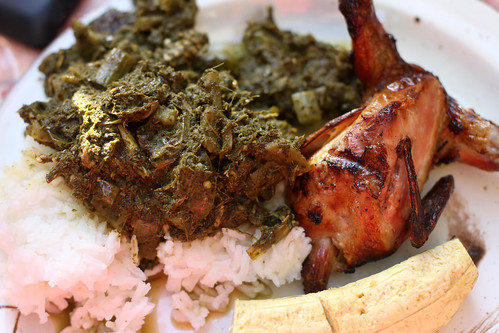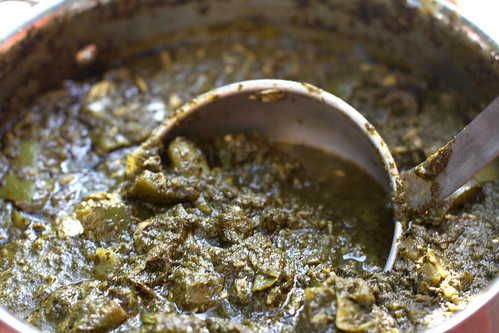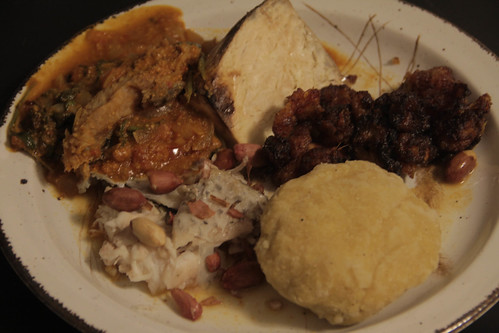 When I asked for fermented cornflour at Owa Afrikan Market, the kindly shopkeeper replied, "Kenkey? Oh, that's from Ghana. We're a Nigerian store!" I didn't have much better luck at Diaby African Market, which is run by shopkeepers from Cote d'Ivoire who are equally friendly but equally devoid of kenkey. Just as I'd begun to grow a bit fatigued of what seem to be a limited range of very common African staples -- smoked fish, palm oil, cassava, yam, plantain, peanuts -- I was so happy to discover first-hand some real regional variation that I quickly overcame the disappointment of not finding what I was looking for. (Plus, as you'll see below, I got creative and found my way around it.)
When I asked for fermented cornflour at Owa Afrikan Market, the kindly shopkeeper replied, "Kenkey? Oh, that's from Ghana. We're a Nigerian store!" I didn't have much better luck at Diaby African Market, which is run by shopkeepers from Cote d'Ivoire who are equally friendly but equally devoid of kenkey. Just as I'd begun to grow a bit fatigued of what seem to be a limited range of very common African staples -- smoked fish, palm oil, cassava, yam, plantain, peanuts -- I was so happy to discover first-hand some real regional variation that I quickly overcame the disappointment of not finding what I was looking for. (Plus, as you'll see below, I got creative and found my way around it.)

Our guest of honor was Jessica, whose family is from Ghana and spent several years there. She cooked up some amazing spicy plantains! Also on hand were Anthony, Angad, Melanie, Christen, and Ignacio.
Shito | Dried shrimp pepper sauce | Recipe
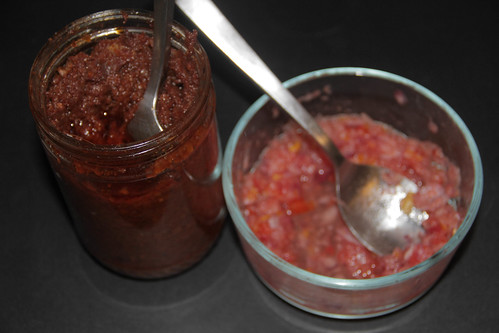
In addition to being a word that makes any English speaker giggle, shito means hot pepper. It also refers, by synecdoche, to any spicy sauce, whether fresh or preserved. The fresh version, on the right, is so simple as to not require a recipe (onion, tomato, hot pepper, salt, pepper, food processor, done), while this one is both more complex and also not as spicy, as the bulk of the volume is actually pungent dried shrimp. As far as I can tell, this condiment, which can also go by the confusing name "black pepper," is like the ketchup of Ghana. It goes well with dishes made of red palm oil and other strong flavors, adding both depth and zing, but I made the mistake a few days later of adding it to a French-style braised chicken and that wasn't the beset combo.
Kenkey | Steamed fermented corn dumplings | Recipe

Since I couldn't find the pre-fermented cornflour, I had to figure out how to make it myself. The traditional method is to simply mix some cornflour and water, leave it for a few days, and let the naturally-occurring yeast and bacteria in the air land and multiply. Unfortunately, whenever I've done that in New York, whatever lands on the surface makes it smell like bad cheese and taste worse. But I had an idea! The recipe I used for injera suggested using a sourdough starter to give it the right microbes, beating the stuff in the air to the punch. So I mixed in a bit of my sourdough starter with the corn, and the next day, I had delightfully sour corn mush. After that, I followed the recipe to heat the mush and then steam it, though I might have cooked it too long because it came out rather firm. A nice, tangy starch that's different from the usual fufu!
Grilled Tilapia | Recipe
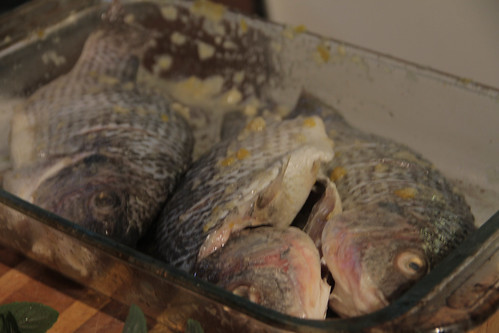
Similar to what I made for the Cote d'Ivoire meal, I slashed up some tilapia, marinated it with an onion-chili-ginger mixture, and grilled it up. The flesh didn't turn out as well and kind of came off the bone as much rather than firm flesh. Maybe I didn't have the grill up high enough. But it was definitely tasty, and went well with the kenkey.
Palaver Sauce | Spinach stew | Recipe

Why this stew of greens, red palm oil and peanut butter is named for the Portuguese word for a discussion or a talk is the subject of much speculation and no conclusion. It's stranger still to me because the core ingredients show no influence of European or new world foods. In any event, I made this with spinach rather than trying to make a hard chunk of long-frostbitten greens work, and used the ubiquitous dry-smoked fish for flavoring. Happily, I also have an African basil plant growing in the back yard, which Jessica confirmed is the right seasoning for this dish. This strongly-flavored and -textured stew had a good foil in some grilled yam.
Kelewele | Spicy plantain bits
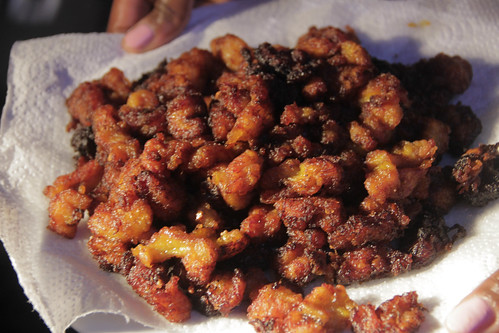
Ignore anything I said above and just concentrate on this part. I followed Jessica's instructions to get plantains with blackened skin, they were so ripe I had to keep them outside to avoid keeping the fruit flies inside! She showed up with a marinade of ginger, chili, and citrus, cut the plantains into little pieces, and marinated them. Then she fried them to within an inch of burning, so they were so amazingly sweet and caramelized yet still gingery and tangy and a bit spicy. This was by far the hit of the meal!
Jessica also brought a delicious ginger drink. Once again, thanks to her for making our meal so special and authentic!
Laura apologizes for the quality of the photos, the lens she normally uses for food photography needs repair.
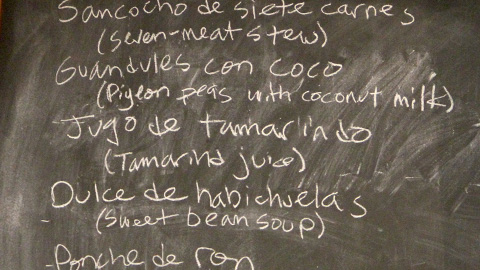




















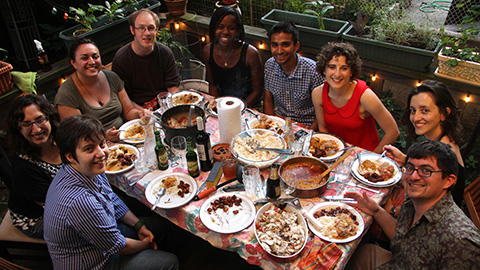

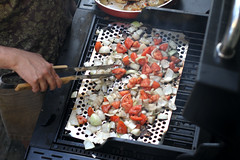






 The larger better-known of the two countries named after the Congo River is the Democratic Republic of Congo, the former Zaire and previously a Belgian colony, but that shows up in the D's. This meal is from the north side of the river, the Republic of Congo, the former French colony, sometimes known as Congo-Brazzaville after its capital.
The larger better-known of the two countries named after the Congo River is the Democratic Republic of Congo, the former Zaire and previously a Belgian colony, but that shows up in the D's. This meal is from the north side of the river, the Republic of Congo, the former French colony, sometimes known as Congo-Brazzaville after its capital.